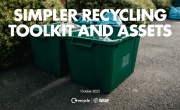European Commission makes circular economy monitoring proposal
The EU’s Circular Economy Package (CEP) has taken another step closer to fruition after the European Commission finalised its proposal for a Circular Economy Monitoring Framework to track the EU’s progress against the ambitions and objectives stated in the CEP.
The CEP, originally proposed by the European Commission in 2015, is a set of laws and actions designed to guarantee a more resource-efficient future for Europe and includes four legislative proposals to six pieces of waste legislation (Waste framework directive, Packaging waste directive, Landfill directive, Directive on electrical and electronic waste, on end-of-life vehicles; and on batteries and accumulators and waste batteries and accumulators).
In a meeting in Brussels on 8 March, the monitoring group of the European Economic and Social Committee discussed the draft Circular Economy Monitoring Framework, which states that ‘monitoring the key trends and patterns is key to understanding how the various elements of the circular economy are developing over time, to helping identify success factors in Member States and to assessing whether sufficient action has been taken. The results of monitoring should form the basis for setting new priorities towards the long-term objective of a circular economy.’
The final version of the Framework now includes ten indicators of progress towards the circular economy, within the four overarching themes of production and consumption, waste management, secondary raw materials and competitiveness and innovation. The ten indicators are:
- EU self-sufficiency for raw materials
- Green public procurement
- Waste generation
- Food waste
- Overall recycling rates
- Recycling rates for specific waste streams
- Contribution of recycled materials to raw materials demand
- Trade in recyclable raw materials
- Private investments, jobs and gross value added
- Patents
The indicators are available and kept up to date on the European Commission’s Eurostat page, where you can also track the progress of individual Member States against the indicators using collected data.
The above indicators were chosen to cover the main elements of the circular economy, and are based on existing data as much as possible – drawn largely from the Resource Efficiency Scoreboard and the Raw Materials Scoreboard – in order to reduce the administrative burden.
The European Commission intends to improve the knowledge base and data availability for measuring circular economy progress, with work ongoing to develop more accurate methodologies for collecting data on green public procurement and food waste. The Commission is also proposing to harmonise methodologies for calculating municipal and packaging waste recycling rates, and to fund research projects working on better data collection through the Horizon 2020 funds.
First findings
The finalised Monitoring Framework includes a rundown of where the EU currently stands against the circular economy indicators.
For production and consumption, the Framework states that ‘some progress can be observed towards more circular trends in production and consumption’ but there is still ‘considerable’ room for improvement. In terms of self-sufficiency, the EU is largely self-sufficient for most non-metallic materials but relies heavily on imports for critical raw materials. With waste generation, EU municipal waste generation per capita has dropped by eight per cent since 2006, although significant variations exist between Member States. Meanwhile, EU food waste across the supply chain fell from 81 to 76 million tonnes between 2012 and 2014. Further data development is required for green public procurement.
On the waste management front, there have been generally ‘positive developments’, though there remains ‘significant’ scope for improvement. EU municipal waste recycling rates increased from 37 per cent to 46 per cent between 2008 and 2016, with five Member States recycling more than half of their municipal waste. However, five Member States are also still below 25 per cent.
Packaging waste recycling rates increased from 62 to 66 per cent between 2008 and 2015, while the rate for plastic packaging remains significantly lower at 40 per cent – though the European Commission has suggested it will be legislating on single-use plastics by the summer. The recycling of municipal biowaste increased by 23 per cent between 2007 and 2016, while 20 Member states have reportedly achieved the 70 per cent recovery rate target by 2020 for construction and demolition waste, the biggest waste stream in the EU.
The EU’s performance on secondary raw materials is currently modest, with the contribution of recycled materials to overall materials ‘relatively low’, although demand is increasing. At the moment, recycled materials satisfy only around 10 per cent of the EU demand for materials, although trade within the EU of plastics, paper and cardboard, copper, aluminium, nickel and precious metals waste grew significantly between 2004 and 2016.
Finally, the EU appears to be performing well in terms of innovation and investment in the circular economy. In 2014, there were around €15 billion (£13.1 billion) of private investments in economic sectors relevant to the circular economy, with more than 3.9 million jobs in these sectors, while patents on recycling and secondary raw materials increased by 35 per cent between 2000 and 2013.
The road to the circular economy
The finalised Circular Economy Monitoring Framework will now go on to be discussed at the third Circular Change Conference in Maribor, Slovenia, on 11 May, with specific workshops to be dedicated to circular metrics and indicators.
The Monitoring Framework is a key component in the Circular Economy Package, which will now face a final vote in the European Parliament and European Council after it was endorsed by EU ambassadors in February.
And it appears as though the end is in site for what has been a drawn-out legislative process. An initial draft package was released by the European Commission in 2014 before being scrapped following the Juncker Commission’s accession to the helm of the EU, with a new package being published in 2015 with a headline target of 65 per cent recycling by 2030.
Trilogue negotiations between the European Commission, the European Council and the European Parliament began in May 2017 after each entity had agreed a negotiating position.
While the course of negotiations did not run smooth, with several nations labelled ‘laggards’ for their supposed lack of ambition on targets, compared to the European Commission’s 65 per cent proposal and the European Parliament’s argument to increase that to 70 per cent, agreement was eventually reached before the end of 2017.
EU member states will be obliged to reach a 55 per cent municipal recycling rate by 2025, 60 per cent by 2030 and 65 per cent by 2035. Specific targets for packaging are also included for all packaging (70 per cent), plastic (55 per cent), wood (30 per cent), ferrous metals (80 per cent), aluminium (60 per cent), glass (75 per cent) and paper and cardboard (85 per cent).
In addition to material-specific targets, member states will have until 1 January 2025 to set up a separate collection for textile waste and hazardous waste from households, and until 31 December 2023 to ensure that bio-waste is either collected separately or recycled at source (e.g. home composting), while no recyclable material should be being sent to landfill by 2030. Provisions for extended producer responsibility are also included in the package.
You can read the European Commission’s finalised proposal for the Circular Economy Monitoring Framework on the Commission’s website.









